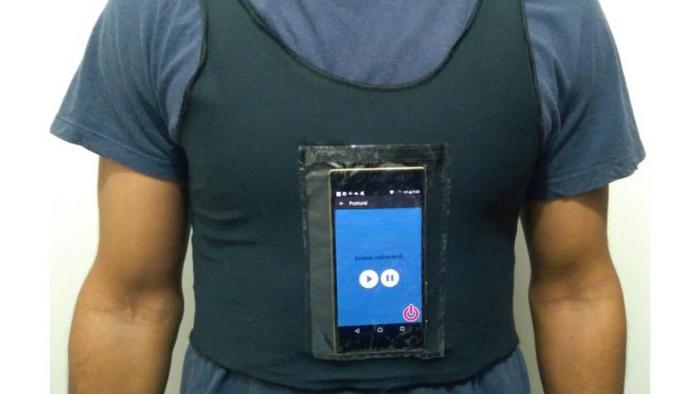
Brazilian researchers have achieved a remarkable breakthrough in stroke rehabilitation through the development of an innovative cell phone application. This application leverages the capabilities of mobile technology to offer a practical solution for people who have suffered strokes, particularly focusing on a condition known as hemiparesis. This condition often manifests as weakness or paralysis on one side of the body, significantly impairing the individual’s quality of life and daily functioning. By integrating a sensor mechanism with a smartphone, the app aids patients in adjusting their body posture while undergoing rehabilitation, ultimately enhancing their recovery process.
The app utilizes an accelerometer embedded in the smartphone to assess the alignment and inclination of the user’s body position. The intelligent software processes this data to provide real-time feedback. Patients receive guidance through a combination of auditory cues, vibrations, or visual prompts, prompting them to correct their posture. This multipronged approach is designed to facilitate an interactive and engaging rehabilitation experience that empowers users, encouraging autonomy and self-correction. The primary objective of this research is to address the pervasive issue of body misalignment in individuals with hemiparesis, enhancing both their physical health and self-awareness.
Hemiparesis presents formidable challenges for patients, as it leads to diminished spatial awareness and sensitivity. This can create a vicious cycle where patients are often unaware of their postural misalignments, resulting in muscle discomfort or pain due to improper alignment. In everyday situations, hemiparetic individuals face significant hurdles in performing tasks such as walking, preparing meals, or engaging in social activities. The innovative application developed by the research team aims not only to improve posture during rehabilitation sessions but also to cultivate a sense of body awareness that is crucial for regaining independence.
Amanda Polin Pereira, who directs the project as a professor in the Department of Occupational Therapy at the Federal University of São Carlos, emphasizes the essential need for effective rehabilitation tools. Drawing from her observations in the field, Pereira recognized a gap in the availability of technology-driven solutions designed exclusively for hemiparesis. This prompted her to spearhead the project, collaborating with Olibário José Machado Neto, a doctoral student at the University of São Paulo’s Institute of Mathematical and Computer Sciences. The team’s multidisciplinary approach has resulted in a truly unique application informed by both medical expertise and technological innovation.
As the research progressed, iterative development played a crucial role in enhancing the app’s functionality and ease of use. Through engagements with occupational therapists and physiotherapists, the research team gathered invaluable insights regarding the day-to-day rehabilitation challenges faced by stroke survivors. Feedback garnered from both therapists and patients has proven pivotal in refining the app’s design, ensuring that it meets the practical needs of users. The collaborative effort underscores the importance of integrating user perspectives into the development of healthcare technology, ultimately fostering a product that resonates with patients’ realities.
The culmination of the project resulted in three successive iterations of the application, reflecting a shift in focus toward simplicity and effectiveness. Researchers initially contemplated the concept of creating specialized wearable devices. However, through a process of experimentation and user feedback, they realized that a more straightforward solution was necessary. Rather than engineering complex wearable attire, the team devised a method to secure the cellphone onto the patient’s clothing, allowing users to benefit from the app without extensive modifications to their wardrobe.
By capitalizing on existing smartphone technology, the researchers have made substantial strides in wearable tech development without incurring significant costs. This accessibility factor is critical, as it allows a more considerable number of users to engage with the application, potentially transforming rehabilitation experiences for many more individuals. Continuous monitoring of the user’s posture thus becomes feasible, with the smartphone’s built-in accelerometer tracking movements and providing feedback to guide patients in real-time.
Excitingly, this application not only enhances the rehabilitation experience for patients but also aids therapists by enabling them to allocate their attention to other pressing aspects of a patient’s rehabilitation. The system’s ability to track and monitor postural alignment allows healthcare professionals to optimize their interventions, thus promoting a more efficient rehabilitation process. Furthermore, ongoing studies are expected to investigate the long-term impacts of utilizing the app at home, thereby extending its benefits beyond clinical settings.
As researchers look to the future, the overarching goal is to make this promising application freely available to users. This commitment to accessibility underscores the team’s dedication to improving the lives of stroke survivors and is a testament to the foundational belief that rehabilitation should be both effective and inclusive. Ongoing collaboration and funding will be essential to ensure that the app remains up to date and continues to benefit its users over time.
In conclusion, the intersection of technology and healthcare has paved the way for significant advancements in stroke rehabilitation therapies. The innovative app developed by Brazilian researchers is a testament to the potential of smartphone technology to transform rehabilitation practices for individuals with hemiparesis. By harnessing the promising capabilities of wearable devices, the research team has made substantial contributions to enhancing patient autonomy and body awareness, thereby improving overall rehabilitation outcomes. This exciting progression not only highlights the necessity for continued research in this area but also calls for further investment and collaboration in developing user-centric solutions that place the needs of patients at the forefront of design and implementation.
Subject of Research: Development of a smartphone application for stroke rehabilitation focusing on hemiparesis.
Article Title: Wearable Smartphone-Based Multisensory Feedback System for Torso Posture Correction: Iterative Design and Within-Subjects Study.
News Publication Date: 13-Dec-2024.
Web References: Link to article.
References: Published in JMIR Aging.
Image Credits: USP.
Keywords
Tags: accelerometer in stroke therapyBrazilian research on stroke recoveryenhancing quality of life after strokehemiparesis treatment solutionsinnovative health solutions for rehabilitationinteractive rehabilitation for hemiparesismobile app for stroke rehabilitationpatient empowerment in rehabilitationposture correction for stroke survivorsself-correction techniques for hemiparesissmartphone applications for healthstroke recovery technology





